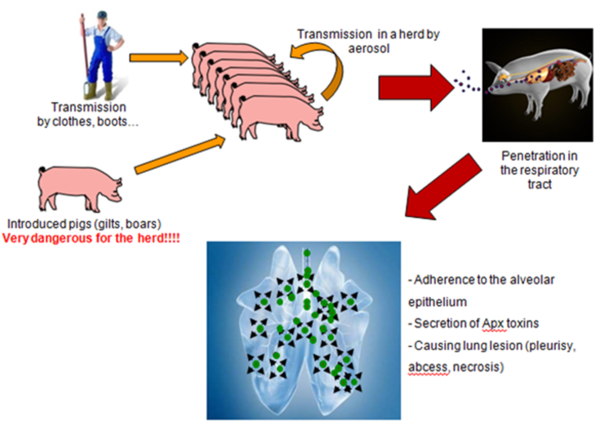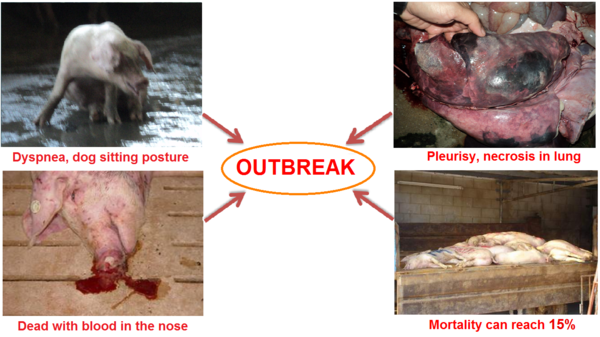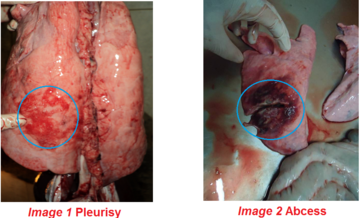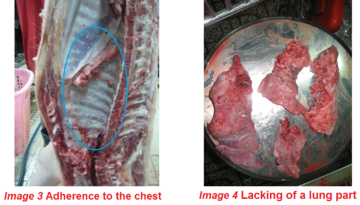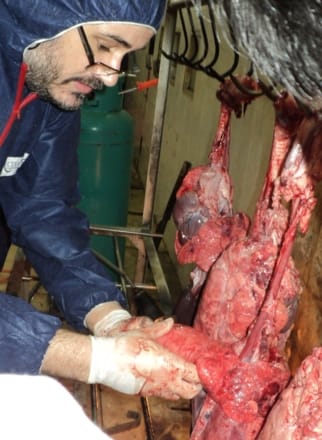.
--> What is A. pleuropneumoniae?
--> How can A. pleuropneumoniae spread?
--> How to recognize A. pleuropneumoniae?
--> How to confirm A. pleuropneumoniae?
--> How to treat A. pleuropneumoniae?
--> How to prevent A. pleuronpneumoniae?
--> Conclusion
.
PORCINE PLEUROPNEUMONIA CAUSED BY ACTINOBACILLUS PLEUROPNEUMONIAE
- THE THREAT FOR YOUR FATTENING PIGS -
By PHẠM Châu Giang, Ceva Animal Health Vietnam
.
WHAT IS A. PLEUROPNEUMONIAE?
A. pleuropneumoniae is coccobacilli, Gram negative, encapsulated (J.P.Euzéby, 1998).
There are 15 serotypes distributed following the zones. Each serotype can produce exotoxin Apx I, II or III. These exotoxins are the main factor to damage the lungs and seriously decrease the performances (E. Brunier, 2010).
Table: The serotypes of A. pleuropneumoniae with the Apx toxin patterns (Nattavut, 2010)
.
HOW CAN A. PLEUROPNEUMONIAE SPREAD?
- Pig to pig: by droplets less than 2,5m, by boots, rodents, birds.
- Herd to herd: A. pleuropneumoniae can’t be transmitted by air in a long distance. The main factor is the carrying pigs (D. Maes, 2011).
Figure 1 The transmission and pathogeny of A. pleuropneumoniae
.
HOW TO RECOGNIZE A. PLEUROPNEUMONIAE?
(Source: respig.com, E. Brunier and P.C. Giang)
Figure 2 Symptoms of A. pleuropneumoniae
1. Outbreak:
- Usually in the fattening period (from 14 weeks of age).
- The pigs have high fever, cyanosis, anorexia, abdominal breathing, and apathy.
- Dead with blood discharge in the nose. The necropsy lungs have pleurisy, necrosis.
- The mortality can reach 15% (R. Krejci, 2010.
2. Subacute and chronic forms:
- The pigs have coughing, low to moderate fever, dyspnea, decrease of appetite, heterogeneous growth.
- The slaughtered lungs have a high level of pleurisy lesions related to A. pleuropneumoniae: pleurisy, abscess, adherence to the chest (E. Brunier, 2010).
.
HOW TO CONFIRM A. PLEUROPNEUMONIAE?
To have the general profile in the farm, the farmers can coordinate these methods:
- The herd history: Where do the gilts and boars come from? Are they vaccinated? …
- The situation of the farm: Clinical signs, lung lesions of the sick pigs, lung lesions scoring in the slaughterhouses,…
- The diagnosis in the laboratory: PCR, ELISA.
(Source P.C.Giang)
Figure 3 Lung lesions related A. pleuropneumoniae observed in slaughterhouses
.
HOW TO TREAT A. PLEUROPNEUMONIAE?
- The sick animal must be marked and all of the batches or groups must be treated. The antibiotic must be applied in a very early stage of A. pleuropneumoniae (E. Brunier, 2010).
- The antibiotherapy can help but cannot remove the Apx toxin. The pigs can die and the losses of performance still happen.
- The survivor pigs after an outbreak can become carriers. The risk of a flare up after an outbreak is very high (D. Maes, 2011).
.
HOW TO PREVENT A. PLEURONPNEUMONIAE?
The farmers should check the lungs every 3-6 months to know about the situation of their farms.
Image 5 Lung scoring
Then, there are 3 main ways to prevent A. pleuropneumoniae:
1. Biosecurity:
- Introduced pigs (gilts, boars) come from the A. pleuropneumoniae-free farm or at least vaccinated (vaccination does prevent carriage by no mean).
- The disinfection is carefully followed.
- The farmers respect the standard of density, ventilation and temperature.
2. Antibio – metaphylaxia
Advantage: This method can help to control the situation at the moment it is applied.
Threat:
- The losses still happens due to the Apx toxin.
- The risk of resistance against the antibiotic is very high and will decrease the efficacy of the antibiotic in the future.
- The risk of residue of antibiotic in the meat, which can influence the human health.
3. Vaccination
- This is the long term solution.
- The farmers must use a vaccine that can cover all serotypes to have a full protection.
- The farmers should choose a vaccine avoiding PVR and maximize the technical result.
.
CONCLUSION
The Porcine Pleuropneumonia caused by Actinobacillus pleuropneumoniae is an important threat for the farm. The loss can be lead by the mortality (especially in heavy pigs), the decreasing of performance (such as PCR or ADG). The treatment of A. pleuropneumoniae outbreak does not give a good efficacy. To prevent the A. pleuropneumoniae, in associate with the biosecurity, an antibio-metaphylaxis can be done but it is not the long term solution for the farm. The long term solution is the vaccination. This one must be carefully looked at to make it useful. In one next article we will give you more detail about this.
.
<< Back to Porcine Pleuropneumonia
<< Back to Disease Informations
Related topics: threat symptom lung scoring lesion treat prevent pleuropneumonia actinobacillus vaccination

 Corporate Website
Corporate Website
 Africa
Africa
 Argentina
Argentina
 Asia
Asia
 Australia
Australia
 Belgium
Belgium
 Brazil
Brazil
 Bulgaria
Bulgaria
 Canada (EN)
Canada (EN)
 Chile
Chile
 China
China
 Colombia
Colombia
 Denmark
Denmark
 Egypt
Egypt
 France
France
 Germany
Germany
 Greece
Greece
 Hungary
Hungary
 Indonesia
Indonesia
 Italia
Italia
 India
India
 Japan
Japan
 Korea
Korea
 Malaysia
Malaysia
 Mexico
Mexico
 Middle East
Middle East
 Netherlands
Netherlands
 Peru
Peru
 Philippines
Philippines
 Poland
Poland
 Portugal
Portugal
 Romania
Romania
 Russia
Russia
 South Africa
South Africa
 Spain
Spain
 Sweden
Sweden
 Thailand
Thailand
 Tunisia
Tunisia
 Turkey
Turkey
 Ukraine
Ukraine
 United Kingdom
United Kingdom
 USA
USA
 Vietnam
Vietnam


